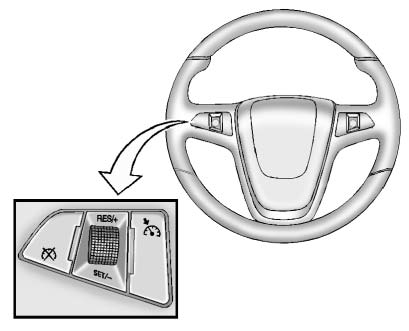Cruise Control
With cruise control, the vehicle can maintain a speed of about 40 km/h (25 mph) or more without keeping your foot on the accelerator. Cruise control does not work at speeds below 40 km/h (25 mph).
On vehicles with the Traction Control System (TCS) or the Stabilitrak® system may begin to limit wheel spin while you are using cruise control. If this happens, the cruise control will automatically disengage. See Traction Control System (TCS) or StabiliTrak® System .
![]() WARNING
WARNING
Cruise control can be dangerous where you cannot drive safely at a steady speed. So, do not use the cruise control on winding roads or in heavy traffic.
Cruise control can be dangerous on slippery roads. On such roads, fast changes in tire traction can cause excessive wheel slip, and you could lose control. Do not use cruise control on slippery roads.

The cruise control buttons are located on the steering wheel.
 (On/Off): Press to turn the cruise control system on and off.
(On/Off): Press to turn the cruise control system on and off.
An indicator light will turn on or off in the instrument panel cluster.
 (Cancel): Press to disengage cruise control without erasing the set speed from memory.
(Cancel): Press to disengage cruise control without erasing the set speed from memory.
RES/+ (Resume/Accelerate):
Move the thumbwheel up to make the vehicle resume to a previously set speed or to accelerate.
SET/− (Set/Coast): Move the thumbwheel down to set a speed or to make the vehicle decelerate.
Setting Cruise Control
If the cruise button is on when not in use, it could get bumped and go into cruise when not desired. Keep the cruise control switch off when cruise is not being used.
1. Press 1 to turn cruise control on.
2. Get to the speed desired.
3. Move the thumbwheel down toward SET/− and release it.
The desired set speed briefly appears in the instrument panel cluster.
4. Take your foot off the accelerator pedal.
Resuming a Set Speed
If the cruise control is set at a desired speed and then the brakes are applied, the cruise control is disengaged without erasing the set speed from memory.
Once the vehicle speed reaches about 40 km/h (25 mph) or more, move the thumbwheel up toward RES/+ briefly. The vehicle returns to the previous set speed and stays there.
Increasing Speed While Using Cruise Control
If the cruise control system is already activated:
► Move the thumbwheel up toward RES/+ and hold it until the desired speed is reached, then release it.► To increase vehicle speed in small amounts, move the thumbwheel up toward RES/+ briefly and then release it. Each time this is done, the vehicle goes about 1.6 km/h (1 mph) faster.
Reducing Speed While Using Cruise Control
If the cruise control system is already activated:
► Move the thumbwheel toward SET/− and hold until the desired lower speed is reached, then release it.► To slow down in small amounts, move the thumbwheel toward SET/− briefly. Each time this is done, the vehicle goes about 1.6 km/h (1 mph) slower.
Passing Another Vehicle While Using Cruise Control
Use the accelerator pedal to increase the vehicle speed. When you take your foot off the pedal, the vehicle will slow down to the previous set cruise control speed.
Using Cruise Control on Hills
How well the cruise control works on hills depends upon the vehicle speed, load, and the steepness of the hills. When going up steep hills, you might have to step on the accelerator pedal to maintain the vehicle speed. When going downhill, you might have to brake or shift to a lower gear to maintain the vehicle speed. When the brakes are applied, the cruise control is disengaged.
Ending Cruise Control
There are three ways to end cruise control:
► Step lightly on the brake pedal or clutch to disengage cruise control. ► Press on the steering wheel.
► Press
on the steering wheel.
► Press  on the steering wheel to turn off the cruise control.
on the steering wheel to turn off the cruise control.
Erasing Speed Memory
The cruise control set speed is erased from memory by pressing the  button or if the ignition is turned off.
button or if the ignition is turned off.
See also:
Side Blind Zone Alert (SBZA)
The vehicle may have a Side Blind Zone Alert (SBZA)
system. Read this entire section before using the
system.
WARNING:
SBZA is only a lane changing aid and does not
replace driver vision. SBZA ...
Driving On Grades
Reduce speed and shift to a lower gear before starting down a
long or steep downgrade. If the transmission is not shifted down, the brakes might
have to be used so much that they would get hot and ...
Transferring a Call
Audio can be transferred between the Bluetooth system and the cell phone.
The cell phone must be paired and connected with the Bluetooth system before
a call can be transferred. The connection proc ...


